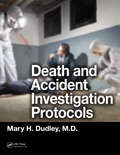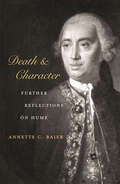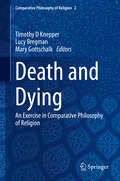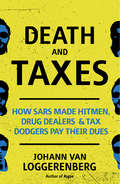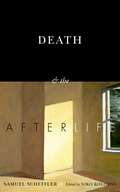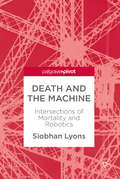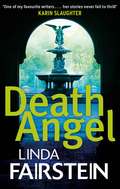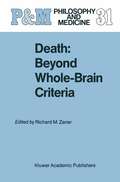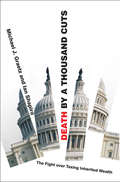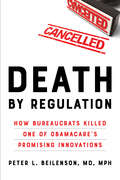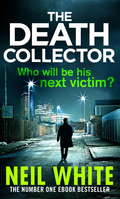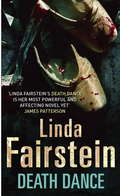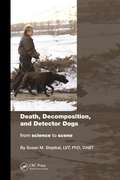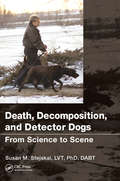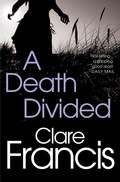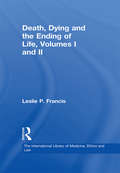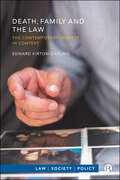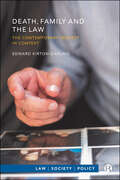- Table View
- List View
Death and Accident Investigation Protocols
by Mary H. DudleyThrough an examination and assessment of the body at a death scene, the medicolegal death investigator (MLDI) must be able to recognize circumstances that point to what manner of death occurred be it natural causes, homicide, suicide, accident, or undetermined. A handy reference for use in the field and in the lab, Death and Accident Investigation
Death and Character: Further Reflections on Hume
by Annette C. BaierReviewing Annette Baier’s 1995 work Moral Prejudices in the London Review of Books, Richard Rorty predicted that her work would be read hundreds of years hence; Baier’s subsequent work has borne out such expectations, and this new book further extends her reach. Here she goes beyond her earlier work on David Hume to reflect on a topic that links his philosophy to questions of immediate relevance—in particular, questions about what character is and how it shapes our lives.Ranging widely in Hume’s works, Baier considers his views on character, desirable character traits, his treatment of historical characters, and his own character as shown not just by his cheerful death—and what he chose to read shortly before it—but also by changes in his writings, especially his repudiation of the celebrated A Treatise on Human Nature. She offers new insight into the Treatise and its relation to the works in which Hume “cast anew” the material in its three books. Her reading radically revises the received interpretation of Hume’s epistemology and, in particular, philosophy of mind.
Death and Dying: An Exercise in Comparative Philosophy of Religion (Comparative Philosophy of Religion #2)
by Timothy D Knepper Lucy Bregman Mary GottschalkThe medicalization of death is a challenge for all the world's religious and cultural traditions. Death's meaning has been reduced to a diagnosis, a problem, rather than a mystery for humans to ponder. How have religious traditions responded? What resources do they bring to a discussion of death's contemporary dilemmas? This book offers a range of creative and contextual responses from a variety of religious and cultural traditions. It features 14 essays from scholars of different religious and philosophical traditions, who spoke as part of a recent lecture and dialogue series of Drake University’s The Comparison Project. The scholars represent ethnologists, medical ethicists, historians, philosophers, and theologians--all facing up to questions of truth and value in the light of the urgent need to move past a strictly medicalized vision.This volume serves as the second publication of The Comparison Project, an innovative new approach to the philosophy of religion housed at Drake University. The Comparison Project organizes a biennial series of scholar lectures, practitioner dialogues, and comparative panels about core, cross-cultural topics in the philosophy of religion. The Comparison Project stands apart from traditional, theistic approaches to the philosophy of religion in its commitment to religious inclusivity. It is the future of the philosophy of religion in a diverse, global world.
Death and Taxes: How SARS made hitmen, drug dealers and tax dodgers pay their dues
by Johann van LoggerenbergNothing in life is certain, except death and taxes – or so the expression goes. And over the past two decades South African criminals and tax dodgers have come to realise this truth the hard way.Tax sleuth Johann van Loggerenberg was at the centre of many of SARS’ high-profile cases during his time there. As far as SARS is concerned all forms of income are subjected to tax, even if by ill-gotten means. Whether you are a drug dealer from Durban, one of the hitmen who shot Brett Kebble or soccer boss Irvin Khoza, you have to pay your dues!Van Loggerenberg relates the riveting inside stories of the investigations into businessmen like Dave King, Billy Rautenbach, Barry Tannenbaum and his ponzi scheme, and others. Over the years he got to know all the scams and dirty tricks in the book and he explains these in plain language.In these investigations the tax authority worked closely with the police, the NPA and the Directorate of Special Operations. However, after a few years SARS became the victim of its own success. In telling the stories of how tax evaders were caught, Van Loggerenberg also shows how the power struggle between different state departments and the phenomenon of state capture in recent years started crippling SARS.
Death and the Afterlife (The Berkeley Tanner Lectures)
by Samuel SchefflerSuppose you knew that, though you yourself would live your life to its natural end, the earth and all its inhabitants would be destroyed thirty days after your death. To what extent would you remain committed to your current projects and plans? Would scientists still search for a cure for cancer? Would couples still want children? In Death and the Afterlife, philosopher Samuel Scheffler poses this thought experiment in order to show that the continued life of the human race after our deaths--the "afterlife" of the title--matters to us to an astonishing and previously neglected degree. Indeed, Scheffler shows that, in certain important respects, the future existence of people who are as yet unborn matters more to us than our own continued existence and the continued existence of those we love. Without the expectation that humanity has a future, many of the things that now matter to us would cease to do so. By contrast, the prospect of our own deaths does little to undermine our confidence in the value of our activities. Despite the terror we may feel when contemplating our deaths, the prospect of humanity's imminent extinction would pose a far greater threat to our ability to lead lives of wholehearted engagement. Scheffler further demonstrates that, although we are not unreasonable to fear death, personal immortality, like the imminent extinction of humanity, would also undermine our confidence in the values we hold dear. His arresting conclusion is that, in order for us to lead value-laden lives, what is necessary is that we ourselves should die and that others should live. Death and the Afterlife concludes with commentary by four distinguished philosophers--Harry Frankfurt, Niko Kolodny, Seana Shiffrin, and Susan Wolf--who discuss Scheffler's ideas with insight and imagination. Scheffler adds a final reply.
Death and the Afterlife (The Berkeley Tanner Lectures)
by Samuel SchefflerSuppose you knew that, though you yourself would live your life to its natural end, the earth and all its inhabitants would be destroyed thirty days after your death. To what extent would you remain committed to your current projects and plans? Would scientists still search for a cure for cancer? Would couples still want children? In Death and the Afterlife, philosopher Samuel Scheffler poses this thought experiment in order to show that the continued life of the human race after our deaths--the "afterlife" of the title--matters to us to an astonishing and previously neglected degree. Indeed, Scheffler shows that, in certain important respects, the future existence of people who are as yet unborn matters more to us than our own continued existence and the continued existence of those we love. Without the expectation that humanity has a future, many of the things that now matter to us would cease to do so. By contrast, the prospect of our own deaths does little to undermine our confidence in the value of our activities. Despite the terror we may feel when contemplating our deaths, the prospect of humanity's imminent extinction would pose a far greater threat to our ability to lead lives of wholehearted engagement. Scheffler further demonstrates that, although we are not unreasonable to fear death, personal immortality, like the imminent extinction of humanity, would also undermine our confidence in the values we hold dear. His arresting conclusion is that, in order for us to lead value-laden lives, what is necessary is that we ourselves should die and that others should live. Death and the Afterlife concludes with commentary by four distinguished philosophers--Harry Frankfurt, Niko Kolodny, Seana Shiffrin, and Susan Wolf--who discuss Scheffler's ideas with insight and imagination. Scheffler adds a final reply.
Death and the Machine: Intersections of Mortality and Robotics
by Siobhan LyonsThis book challenges conventional notions of biological life and death in the area of robotics, discussing issues such as machine consciousness, autonomous AI, and representations of robots in popular culture. Using philosophical approaches alongside scientific theory, this book offers a compelling critique on the changing nature of both humanity and biological death in an increasingly technological world.
Death and the Machine: Intersections of Mortality and Robotics
by Siobhan LyonsThis book challenges conventional notions of biological life and death in the area of robotics, discussing issues such as machine consciousness, autonomous AI, and representations of robots in popular culture. Using philosophical approaches alongside scientific theory, this book offers a compelling critique on the changing nature of both humanity and biological death in an increasingly technological world.
Death Angel (Alexandra Cooper #15)
by Linda Fairstein'Maybe she blessed the waters a century ago, but now she's a magnet for murder. She's an angel all right,' Mike said, staring at the beautiful sunlit figure that towered over us. 'A death angel.'In New York's Central Park, Assistant DA Alexandra Cooper and Detective Mike Chapman race to track down a serial killer before yet another young woman is found dead. The enormous urban park, a sanctuary in the middle of the city for thousands of New Yorkers and tourists who fill it every day, may very well become a hunting ground at night for a killer with a twisted mind . . .Once again, Linda Fairstein thrills with an explosive page-turner filled with a shocking realism that only she can deliver.
Death: Beyond Whole-Brain Criteria (Philosophy and Medicine #31)
by Richard M. ZanerFrom the tone of the report by the President's Commission for the Study of Ethical Problems in Medicine and Biomedical and Behavioral Re search, one might conclude that the whole-brain-oriented definition of death is now firmly established as an enduring element of public policy. In that report, Defining Death: Medical, Legal and Ethical Issues in the Determination of Death, the President's Commission forwarded a uni form determination of death act, which laid heavy accent on the signifi cance of the brain stem in determining whether an individual is alive or dead: An individual who has sustained either (1) irreversible cessation of circulatory and respiratory functions, or (2) irreversible cessation of all functions of the entire brain, including the brain stem, is dead. A determination of death must be made in accordance with accepted medical standards ([1], p. 2). The plausibility of these criteria is undermined as soon as one confronts the question of the level of treatment that ought to be provided to human bodies that have permanently lost consciousness but whose brain stems are still functioning.
Death by a Thousand Cuts: The Fight over Taxing Inherited Wealth
by Michael J. Graetz Ian ShapiroThis fast-paced book by Yale professors Michael Graetz and Ian Shapiro unravels the following mystery: How is it that the estate tax, which has been on the books continuously since 1916 and is paid by only the wealthiest two percent of Americans, was repealed in 2001 with broad bipartisan support? The mystery is all the more striking because the repeal was not done in the dead of night, like a congressional pay raise. It came at the end of a multiyear populist campaign launched by a few individuals, and was heralded by its supporters as a signal achievement for Americans who are committed to the work ethic and the American Dream. Graetz and Shapiro conducted wide-ranging interviews with the relevant players: members of congress, senators, staffers from the key committees and the Bush White House, civil servants, think tank and interest group representatives, and many others. The result is a unique portrait of American politics as viewed through the lens of the death tax repeal saga. Graetz and Shapiro brilliantly illuminate the repeal campaign's many fascinating and unexpected turns--particularly the odd end result whereby the repeal is slated to self-destruct a decade after its passage. They show that the stakes in this fight are exceedingly high; the very survival of the long standing American consensus on progressive taxation is being threatened. Graetz and Shapiro's rich narrative reads more like a political drama than a conventional work of scholarship. Yet every page is suffused by their intimate knowledge of the history of the tax code, the transformation of American conservatism over the past three decades, and the wider political implications of battles over tax policy.
Death by a Thousand Cuts: The Fight over Taxing Inherited Wealth (PDF)
by Michael J. Graetz Ian ShapiroThis fast-paced book by Yale professors Michael Graetz and Ian Shapiro unravels the following mystery: How is it that the estate tax, which has been on the books continuously since 1916 and is paid by only the wealthiest two percent of Americans, was repealed in 2001 with broad bipartisan support? The mystery is all the more striking because the repeal was not done in the dead of night, like a congressional pay raise. It came at the end of a multiyear populist campaign launched by a few individuals, and was heralded by its supporters as a signal achievement for Americans who are committed to the work ethic and the American Dream. Graetz and Shapiro conducted wide-ranging interviews with the relevant players: members of congress, senators, staffers from the key committees and the Bush White House, civil servants, think tank and interest group representatives, and many others. The result is a unique portrait of American politics as viewed through the lens of the death tax repeal saga. Graetz and Shapiro brilliantly illuminate the repeal campaign's many fascinating and unexpected turns--particularly the odd end result whereby the repeal is slated to self-destruct a decade after its passage. They show that the stakes in this fight are exceedingly high; the very survival of the long standing American consensus on progressive taxation is being threatened. Graetz and Shapiro's rich narrative reads more like a political drama than a conventional work of scholarship. Yet every page is suffused by their intimate knowledge of the history of the tax code, the transformation of American conservatism over the past three decades, and the wider political implications of battles over tax policy.
Death by Regulation: How Bureaucrats Killed One of Obamacare's Promising Innovations
by Peter L. BeilensonIn the contentious run-up to the passage of the Affordable Care Act, Congress passed a law to make nonprofit health insurance CO-OPs (formally known as Consumer Operated and Oriented Plans) a viable alternative to the public option. The idea was to create new competition in order to lower health insurance premiums and encourage innovation. Nearly two dozen such low-cost CO-OPs were launched in the wake of the ACA's passage; only four are in operation today.In Death by Regulation, Dr. Peter L. Beilenson tells the story of a group of Maryland-based public health professionals who launched the Evergreen Health Cooperative, only to discover that the ACA law encouraging CO-OPs was a "plastic plant"—a piece of legislation created for optics but never intended to be functional. Over most of its four years of existence, Evergreen succeeded against all odds, prevailing over naysayers, big insurance companies, Congress, and its founders' naïveté. But in an ironic twist, it was bureaucratic hostility from the Centers for Medicare and Medicaid Services—the very Obama administration agency responsible for the CO-OPs—that led to their collective demise.Beilenson traces the huge impact of seemingly small policy decisions on the work of his team and the people their CO-OP was built to serve. He recounts the excitement and satisfaction of launching such a valuable healthcare company, as well as the damage done to scores of employees and tens of thousands of satisfied healthcare customers when bureaucrats ran amok. The only book about these idealistic Obamacare CO-OPs and the obstacles they all faced, Death by Regulation offers an insider view of health policy and the reality of starting an insurance company from scratch.
Death by Regulation: How Bureaucrats Killed One of Obamacare's Promising Innovations
by Peter L. BeilensonIn the contentious run-up to the passage of the Affordable Care Act, Congress passed a law to make nonprofit health insurance CO-OPs (formally known as Consumer Operated and Oriented Plans) a viable alternative to the public option. The idea was to create new competition in order to lower health insurance premiums and encourage innovation. Nearly two dozen such low-cost CO-OPs were launched in the wake of the ACA's passage; only four are in operation today.In Death by Regulation, Dr. Peter L. Beilenson tells the story of a group of Maryland-based public health professionals who launched the Evergreen Health Cooperative, only to discover that the ACA law encouraging CO-OPs was a "plastic plant"—a piece of legislation created for optics but never intended to be functional. Over most of its four years of existence, Evergreen succeeded against all odds, prevailing over naysayers, big insurance companies, Congress, and its founders' naïveté. But in an ironic twist, it was bureaucratic hostility from the Centers for Medicare and Medicaid Services—the very Obama administration agency responsible for the CO-OPs—that led to their collective demise.Beilenson traces the huge impact of seemingly small policy decisions on the work of his team and the people their CO-OP was built to serve. He recounts the excitement and satisfaction of launching such a valuable healthcare company, as well as the damage done to scores of employees and tens of thousands of satisfied healthcare customers when bureaucrats ran amok. The only book about these idealistic Obamacare CO-OPs and the obstacles they all faced, Death by Regulation offers an insider view of health policy and the reality of starting an insurance company from scratch.
The Death Collector (Joe And Sam Parker Ser.)
by Neil WhiteJoe Parker is Manchester's top criminal defence lawyer and Sam Parker - his brother - is a brilliant detective with the Greater Manchester Police force. Together they must solve a puzzling case that is chilling Manchester to the bone... The Death Collector is charming, sophisticated and intelligent, but he likes to dominate women, to make them give themselves to him completely; to surrender their dignity and their lives. He's a collector of beautiful things, so once he traps them he'll never let them go. Joe is drawn into the Death Collector's world and when the case becomes dangerous, Sam is the first person he turns to. In this gripping thriller, danger lurks for not only the Parker brothers, but also those closest to them.
Death Dance: A Novel (Alexandra Cooper #8)
by Linda FairsteinOnce again Linda Fairstein uses her experience as Manhattan's leading DA to create a tantalyzing web of intrigue, betrayal and murder. Teaming up with longtime friends and colleagues, Mike Chapman and Mercer Wallace, Alex Cooper investigates the disappearance of a world-famous dancer, who has vanished from the Metropolitan Opera House. Drawn behind the scenes of New York's theatrical community, the team is haunted by ghosts of the dramatic old theatres - and from their own pasts. At the same time, Alex and Mercer are trying to collar a doctor who's been using his extensive knowledge of and access to drugs to overpower women before assualting them. A spell-binding thriller combining the unique history of New York with fresh insight into the latest forensic techniques.
Death, Decomposition And Detector Dogs: From Science To Scene (PDF)
by Susan M. StejskalDeath, Decomposition, and Detector Dogs: From Science to Scene is designed to help police investigators and Human Remains Detection K9 handlers understand the basics of forensic taphonomy (decomposition) and how to most effectively use a human remains detection (HRD) K9 as a locating tool. The book covers basic anatomy and the physiology of canine olfaction along with some of the unique characteristics that allow a dog to work. Using concise and understandable explanations along with numerous photographs, the book covers the stages of decomposition and how they are affected by the environment; what is currently understood about the chemical profile of odor from human remains; how weather, topography, ground cover and terrain can affect odor dispersion; and different types of mapping and weather data that can be used before and during deployment of the HRD K9. The final chapter ties it all together by providing case reports about decedents who have been found in different locations in a variety of environmental conditions. By learning how these variables can affect how and what is found, handlers and investigators will be better prepared to meet the challenges of their jobs.
Death, Decomposition And Detector Dogs: From Science To Scene (PDF)
by Susan M. StejskalDeath, Decomposition, and Detector Dogs: From Science to Scene is designed to help police investigators and Human Remains Detection K9 handlers understand the basics of forensic taphonomy (decomposition) and how to most effectively use a human remains detection (HRD) K9 as a locating tool. The book covers basic anatomy and the physiology of canine olfaction along with some of the unique characteristics that allow a dog to work. Using concise and understandable explanations along with numerous photographs, the book covers the stages of decomposition and how they are affected by the environment; what is currently understood about the chemical profile of odor from human remains; how weather, topography, ground cover and terrain can affect odor dispersion; and different types of mapping and weather data that can be used before and during deployment of the HRD K9. The final chapter ties it all together by providing case reports about decedents who have been found in different locations in a variety of environmental conditions. By learning how these variables can affect how and what is found, handlers and investigators will be better prepared to meet the challenges of their jobs.
Death, Decomposition, and Detector Dogs: From Science to Scene
by Susan M. StejskalDeath, Decomposition, and Detector Dogs: From Science to Scene is designed to help police investigators and Human Remains Detection K9 handlers understand the basics of forensic taphonomy (decomposition) and how to most effectively use a human remains detection (HRD) K9 as a locating tool. The book covers basic anatomy and the physiology of canine
Death, Decomposition, and Detector Dogs: From Science to Scene
by Susan M. StejskalDeath, Decomposition, and Detector Dogs: From Science to Scene is designed to help police investigators and Human Remains Detection K9 handlers understand the basics of forensic taphonomy (decomposition) and how to most effectively use a human remains detection (HRD) K9 as a locating tool. The book covers basic anatomy and the physiology of canine
A Death Divided: A Death Divided, A Dark Devotion, And Deceit
by Clare FrancisJoe, struggling to survive his job in a high-powered law firm, is faced with the challenge of finding his childhood friend, Jenna, who has been missing for four years. But has she disappeared through choice? Or is she under the powerful influence of her husband, the restless, troubled Chetwood? For Joe, the search is a matter of duty, but also of conscience - for he introduced them to each other, he was enthralled by them both . . . Helped by his prickly girlfriend, Sarah, Joe manages to find the beautiful, faded Jenna, only to realize too late that he has set some terrible events in motion . . .
Death, Dying and the Ending of Life, Volumes I and II (The International Library of Medicine, Ethics and Law)
by Leslie P. FrancisThe two volumes of Death, Dying, and the Ending of Life present the core of recent philosophical work on end-of-life issues. Volume I examines issues in death and consent: the nature of death, brain death and the uses of the dead and decision-making at the end of life, including the use of advance directives and decision-making about the continuation, discontinuation, or futility of treatment for competent and incompetent patients and children. Volume II, on justice and hastening death, examines whether there is a difference between killing and letting die, issues about physician-assisted suicide and euthanasia and questions about distributive justice and decisions about life and death.
Death, Dying and the Ending of Life, Volumes I and II (The International Library of Medicine, Ethics and Law)
by Leslie P. FrancisThe two volumes of Death, Dying, and the Ending of Life present the core of recent philosophical work on end-of-life issues. Volume I examines issues in death and consent: the nature of death, brain death and the uses of the dead and decision-making at the end of life, including the use of advance directives and decision-making about the continuation, discontinuation, or futility of treatment for competent and incompetent patients and children. Volume II, on justice and hastening death, examines whether there is a difference between killing and letting die, issues about physician-assisted suicide and euthanasia and questions about distributive justice and decisions about life and death.
Death, Family and the Law: The Contemporary Inquest in Context (Law, Society, Policy)
by Edward Kirton-DarlingWhen a death is investigated by a coroner, what is the place of the family in that process? This accessibly written book draws together empirical, theoretical and historical perspectives to develop a rich, nuanced analysis of the contemporary inquest system in England and Wales. It investigates theories of kinship drawn from socio-legal research and analyses law, accountability and the legal process. Excerpts of conversations with coroners and officers offer real insights into how the role of family can be understood and who family is perceived to be, and how their participation fundamentally shapes the investigation into a death.
Death, Family and the Law: The Contemporary Inquest in Context (Law, Society, Policy)
by Edward Kirton-DarlingWhen a death is investigated by a coroner, what is the place of the family in that process? This accessibly written book draws together empirical, theoretical and historical perspectives to develop a rich, nuanced analysis of the contemporary inquest system in England and Wales. It investigates theories of kinship drawn from socio-legal research and analyses law, accountability and the legal process. Excerpts of conversations with coroners and officers offer real insights into how the role of family can be understood and who family is perceived to be, and how their participation fundamentally shapes the investigation into a death.
